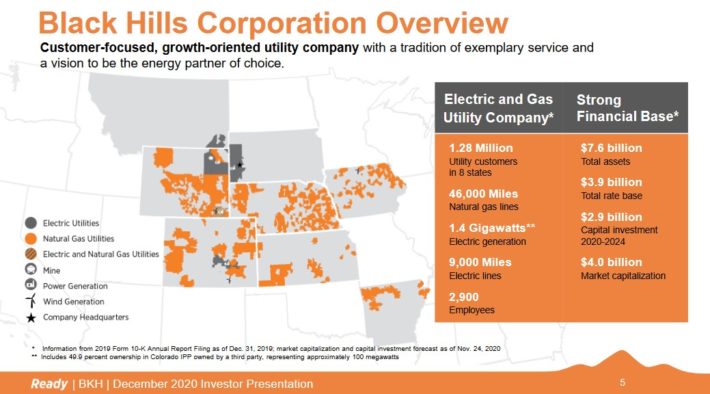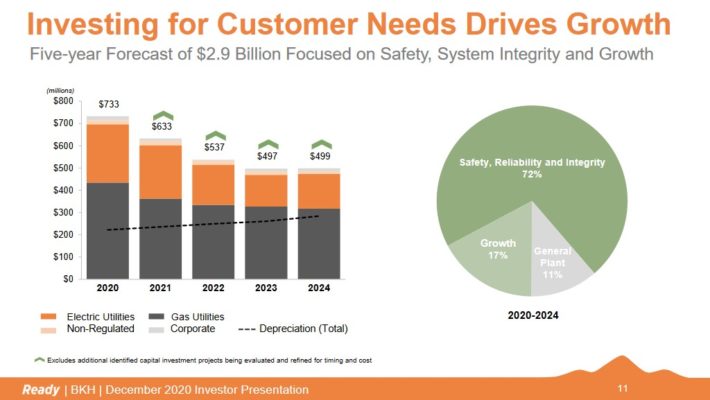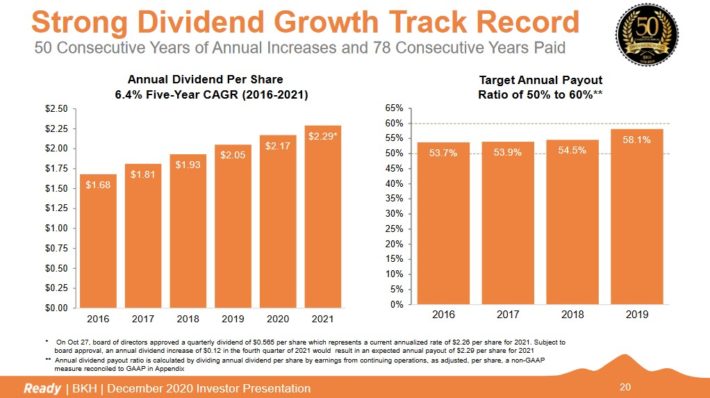Dividend Kings In Focus - Black Hills Corporation
Companies that have at least 50 years of dividend growth are considered Dividend Kings. Dividend growth investors won’t be surprised to find mega-cap stocks like Procter & Gamble (PG) and Coca-Cola (KO) among the Dividend Kings.
But there are also a number of small-cap and mid-cap Dividend Kings. For example, Black Hills Corporation (BKH) is the newest member of the Dividend Kings list, even though it has a market cap of just under $4 billion. This shows that smaller companies can maintain equally impressive streaks of dividend growth.
This article will discuss Black Hills’ business, growth prospects, and valuation in order to determine if shares are worth purchasing now.
Business Overview
Black Hills Corporation is an electric utility that provides electricity and natural gas to customers in Colorado, Iowa, Kansas, Montana, Nebraska, South Dakota, and Wyoming. Black Hills was founded in 1941, and the company is headquartered in Rapid City, South Dakota.
The company has over 1.2 million utility customers in 8 states. Its natural gas assets include 46,000 miles of natural gas lines. Separately, it has 9,000 miles of electric lines and 1.4 gigawatts of electric generation capacity.

Source: Investor Presentation
Utility stocks are typically purchased for their stable profits and low volatility. Black Hills is no exception, as 92% of its assets are regulated. It is also a diversified business, split between complementary natural gas and electric utility businesses.
Black Hills Corporation reported its third-quarter earnings results on November 2nd. The company generated revenues of $350 million during the quarter, a 7% year-over-year increase. Earnings-per-share of $0.58 during the third quarter exceeded the consensus analyst estimate of $0.50 and grew 32% year-over-year. The company’s results showed the resilience of its business model.
Management guidance calls for earnings-per-share at ~$3.65 this year, which would represent a small increase in its profits versus fiscal 2019.
Growth Prospects
Black Hills’ profitability has been rather volatile over the last decade. Overall, earnings-per-share grew by 5% annually from 2009 to 2019. This is not a bad growth rate for a utility, as utilities seldom grow their profits at a high pace. The swings in Black Hills’ profits are primarily based on the impact that weather conditions have on the demand for electricity, for cooling in summer, and natural gas for heating in winter.
Black Hills’ growth over the coming years depends on several factors. This includes rate reviews, which drive revenues and profits per kWh. Another factor is the expansion of the company’s existing assets via new utility infrastructure. Black Hills regularly adds new projects to its growth investment backlog, which currently stands at $2.7 billion for 2020-2024.
The company believes its investments will drive future growth.

Source: Investor Presentation
Black Hills’ planned growth investments include new electric transmission lines and new natural gas pipelines to service its customers. Rate reviews will allow Black Hills to recover investments into its existing systems, thereby more or less guaranteeing increasing revenues, which should lead to rising profits down the road.
In2018, Black Hills exited its oil business, which means that the company is now less impacted by changes in commodity prices. Focusing on its core utility business will likely be a positive for Black Hills going forward. We forecast 4% annual earnings-per-share growth over the next five years.
Competitive Advantages & Recession Performance
To become a Dividend King, a company must inherently possess durable competitive advantages that allow it to outlast competitive threats, and also continue to perform well during recessions. This remains true for Black Hills. Demand for electricity and gas is not overly cyclical, although it is dependent upon weather conditions to some degree. Thus, Black Hills should remain profitable under most circumstances, which allows the company to raise its dividend for decades on end.

Source: Investor Presentation
The fact that customers tend to stick with their provider means that Black Hills operates a relatively stable business model. The company should also be able to weather future recessions well, which creates appeal for more conservative investors.
Another competitive advantage is the company’s strong balance sheet. Black Hills has a high credit rating of BBB+ from Standard & Poor’s and Fitch, which helps reduce its cost of capital. It also has manageable debt maturities, with no large maturities occurring until 2023.
In terms of dividend safety, Black Hills scores highly due to its competitive advantages and defensive business model. Overall, Black Hills Corporation’s dividend payout ratio declined between 2010 and 2019, due to a modest dividend growth rate.
Today, the company pays out roughly 60% of its net profits in the form of dividends. Not only has Black Hills increased its dividend for 50 years, it has paid a dividend to shareholders for the past 78 years. Its decades-long dividend growth track record gives investors assurance that a dividend cut is unlikely from this utility company.
Valuation & Expected Returns
Utilities typically have lower valuations than the broader market, as utilities are generally slower-growth in nature. Indeed, Black Hills stock currently trades for a price-to-earnings ratio of 16.3, based on expected 2020 earnings-per-share of $3.65.
Black Hills’ valuation has moved in a very wide range throughout the past. The company was valued at less than 10 times profits during the midst of the financial crisis, but at as much as 30 times earnings in 2011. Our fair value estimate for Black Hills stock is a P/E ratio of 18.
Shares trade below our fair value estimate right now, which should lead to a modest boost to annual shareholder returns, due to expansion of the valuation multiple. If the P/E ratio expands from 16.3 to 18 over the next five years, shareholder returns would be boosted by 2% annually.
In addition, future earnings-per-share growth and dividends will add to shareholder returns. As previously mentioned, we expect 4% annual EPS growth. The stock also has a 3.8% current dividend yield, leading to total expected returns of 9.8% per year over the next five years.
Final Thoughts
Black Hills is a relatively small utility company, but it has a compelling dividend growth track record, having raised its dividend annually for five decades in a row. We believe that it is highly likely that the company will continue to grow its earnings and its dividend over the coming years. Utilities traditionally offer investors a high level of stability and dividend safety, and Black Hills is no exception.
The stock is currently trading below our fair value estimate, with an attractive dividend yield and a positive future growth outlook. Due to its nearly 4% dividend yield and nearly 10% expected annual returns, we rate the stock a buy for income investors.
Disclosure: Sure Dividend is published as an information service. It includes opinions as to buying, selling and holding various stocks and other securities.
However, the publishers of Sure ...
more


